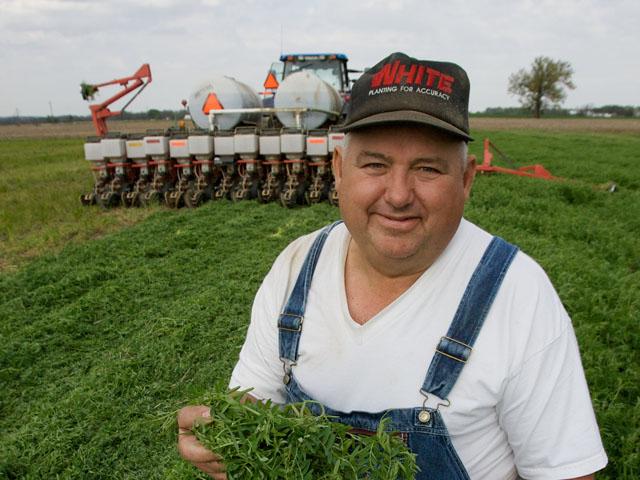Remembering David Brandt
No-Till Legend David Brandt Dies Following Auto Accident
Editor's Note: This story was updated Friday, May 26, to add funeral service information.
**
OMAHA (DTN) -- Long before the days of "climate-smart agriculture," farmer Dave Brandt was a no-till pioneer who reached stardom among his fellow farmers for his cropping practices and folksy way of explaining his 50-plus years of farming just outside of Carroll, Ohio.
Brandt, 76, died Sunday following an auto accident last Thursday in Illinois.
With his overalls, 6-foot long radishes, hairy vetch and sunflowers, Brandt spent his career farming with a strategy of building organic matter in his soil and paying as little for chemical inputs and tillage equipment as possible. In the age of social media, Brandt even became a meme with his photo and the quote, "It ain't much, but it's honest work."
Earlier this year, Brandt was honored by the group No-till on the Plains with its first "Legacy Award," which also was named after him.
In 2011, Brandt served as one of DTN's "View From the Cab" farmers. He noted then how much more there is to learn in agriculture about cover crops and what they can do to help yields while cutting back on chemicals.
"I think I must be the tip of the iceberg as far as learning to use cover crops to do what we want," Brandt said to DTN at the time.
A year later, when USDA's Natural Resources Service started a new soil health campaign, the agency launched it at Brandt's farm.
At the No-till on the Plains conference this year, Brandt spoke about his journey in farming, buying a farm in 1971 that had belonged to his grandfather. Brandt explained he turned to no-till agriculture because of soil erosion.
P[L1] D[0x0] M[300x250] OOP[F] ADUNIT[] T[]
"It wasn't about regenerative agriculture or it wasn't about nutrient density or anything like that," he said." Our farm went from zero to 22% slopes and erosion was a big problem ... We were losing about 25 tons of soil per acre."
Brandt would joke about his early days with equipment. Long before there were 90-million acres of soybeans, Brandt recalled having John Deere engineers out on his farm trying to test the first planters that could plant soybeans.
"So, we're planting cover crops, learning all about them. After about 1,000 failures we had one or two successes. So, I've had all of the failures. You guys don't need to worry about it," he said.
Pointing to one of his photos with an old planter and muddy wheels, Brandt explained, "We grow cover crops to take the moisture out, not to keep it in, but the context is going to be the same."
Talking about tillage radishes, Brandt said he met fellow farmer Steve Groff who pitched him on the idea of tillage radishes. The next thing he knows, he's taking a photo holding one at the local soil and water office.
"I shouldn't be here today. I'm not a spokesman. I'm not a public speaker," Brandt said. "But I went into the local soil office and they took a picture of it. Somehow it got somewhere and the next thing I become the speaker all over the United States talking about tillage radishes."
He explained one of the biggest challenges he faced early on was trying to find basic planting equipment for no-till farming. "I went to the local John Deere dealer and said, 'I'm looking for a planter that will plant corn, soybeans, small grains and cover crops.' He looked at me and says, 'Dammit David, get out of my office.' So, I lost all hope."
Following his journey, Brandt pointed to how the equipment companies have adapted over time to the needs for soil health.
"Today, we have all of this good equipment out there. There is no reason not to no-till today."
When DTN talked to Brandt back in January about USDA's climate-smart programs, Brandt said he had been encouraging USDA Natural Resources Conservation Service Chief Terry Cosby to ensure farmers are educated about cover crops and understand their long-term value to the soil. USDA on Monday sent a statement from Cosby about Brandt's passing.
"I'm saddened to hear of the loss of a great soil health champion -- my friend, advisor, and neighbor, Dave Brandt. He was kind, a dedicated conservationist, a pioneer, and an advocate among farmers for important practices like no-till, cover crops and nutrient management," Cosby said. "NRCS staff members across the country, especially in Ohio, will miss Dave tremendously, as he was always a great conservationist and teacher. He leaves behind a legacy of farmers who are continuing the soil health movement across Ohio and the nation."
**
FUNERAL SERVICES
Services were announced for David William Brandt, who also was a Marine Corps veteran who served in Vietnam. He was preceded in death by his parents, Eleanor and William Brandt, and his beloved wife, Kendra Brandt. He is survived by his children and their spouses, Jay and Ann Brandt, Amy (Brandt) and Charles Gregory Brock. His grandchildren include Christopher, Isaac, Matthew, Therese, Ethan and Sarah.
Family and friends may visit 11 a.m. to 1 p.m. EDT on Friday, June 2, at the Dwayne R. Spence Funeral Home, 650 W. Waterloo Street, Canal Winchester, Ohio.
A celebration of life for friends, colleagues, farmers and numerous others who knew David will be 1 p.m. to 6 p.m. on Saturday, June 3, at David's home, 6100 Basil Western Road, Carroll, Ohio, 43112.
In lieu of flowers, please make donations in his name to David Brandt Legacy Award/Memorial, C/O No-till on the Plains, 672 Avenue L, Protection, Kansas, 67127; the Soil Health Academy, 209 South Oak Ridge Drive, Enterprise, Alabama, 36330; as well as St. Jude Childrens Research Hospital or The Gideons International.
Online condolences may be found at www.spencefuneralhome.com.
**
Chris Clayton can be reached at Chris.Clayton@dtn.com
Follow him on Twitter @ChrisClaytonDTN
(c) Copyright 2023 DTN, LLC. All rights reserved.



